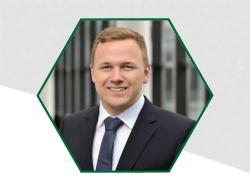Due to the increase of lightweight construction, hybrid components, such as metal and polymer, are getting more and more important. By usage of laser radiation, a connection between these two materials can be created in a two-stage process. In a first step, the surface of the metal component is structured with a continuous wave fiber laser. The high local energy input of the laser beam leads to a thermal distortion in thin metals, which is investigated in this work. The aim of the work is to evaluate measures to reduce thermal distortion. For this, square specimens made of aluminum EN AW 5754 and stainless steel 1.4310 are structured on a large area. In addition to other factors, the influence of material properties, laser parameters and energy deposition on thermal distortion are analyzed. The evaluation is carried out by a three-dimensional measurement of the samples with a profilometer and an optical determination of the deviation from the flat sample at defined measuring points. As a result of the investigation, the use of pause times and jump speed between the laser passes as an approach to reduce thermal distortion is classified. Furthermore, external measures such as clamping the sheet metal or a heat-dissipating base are evaluated and classified with regard to the material properties.
Keywords
- Interaction Of Laser And Metal
- Laser-Based Structuring
- Laser-Joining Of Metal And Polymer
- Thermal Distortion

